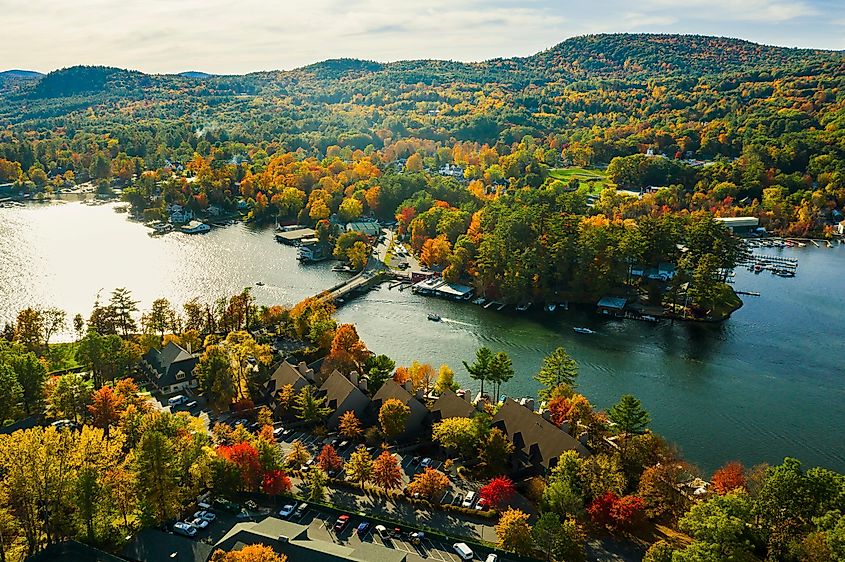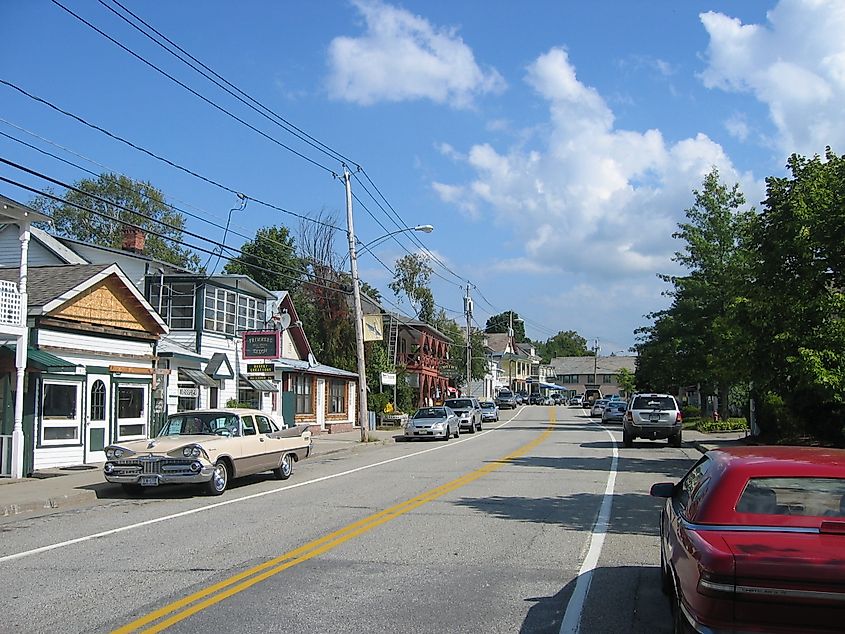
7 Must-See Historic Towns in the Adirondack Mountains
The Adirondack Mountains are an outdoor paradise. The name for the Adirondack Mountains comes from the Mohawk word 'ha-de-ron-dah,' which translates to eaters of trees. While popularly visited for outdoor recreation, the area has a rich history and is an excellent destination for history buffs. In the Adirondacks, there is a connection to the Olympics at Lake Placid and the rumored healing springs of Keeseville. Each town has unique stories to tell about its past. Here, we explore the seven must-see historic towns in the Adirondack Mountains and discover what makes them special.
Lake George

Fall foliage by Lake George at sunset, captured by drone.
Lake George is an area that people adore for its natural beauty. Stretching 32 miles long, the lake is in the Adirondack Mountains and is a popular destination for mountain sports such as hiking, biking, and skiing, as well as water recreation such as kayaking and fishing. People have been enjoying the lake since the area was first inhabited. Settlers came to the lake in the 1600s. In 1755, the lake was named in honor of King George III.
Today, visitors can enjoy local museums and historical sites that tell the story of Lake George. A great way to learn more about the history of conflicts in the area is by visiting the Fort William Henry Museum to learn about the area's history in the French and Indian War era. The museum has interactive exhibits, artifacts, and reenactments demonstrating the history of the region. Other historical sites to visit include Battlefield Park, Fort Ticonderoga, and Saratoga National Historic Park. The Saratoga National Historic Park was an essential location in the American War for Independence. In 1777, this was the spot where American troops beat British invasion Forces. This win changed the world and served to affirm the United States' independence.
Finish off your trip to Lake George with a dreamy horse-drawn carriage ride around town. Enjoying the scenery at a slower pace, you can imagine what the town might have been like hundreds of years ago.
Wilmington

View from the stone path on Whiteface Mountain overlooking Lake Placid and the Adirondack Mountains in Wilmington, New York.
Another popular spot for outdoor recreation in the Adirondack Mountains is Wilmington. However, there's more to the mountain town than skiing and mountain biking. Founded around 200 years ago, Wilmington was originally a quaint farming village on the banks of the Ausable River. The mechanical power of the river drew people to Wilmington. The bridge in Wilmington today looks different than the bridge did in the 1800s. In the 1800s, the bridge stood between a sawmill and a grist mill. The bridge was initially made out of wood and was later replaced with an iron one in 1881. In 1934, a stone bridge replaced the iron one. This is the bridge that stands in town today. A great spot to go to read more about the history of Wilmington is the Cooper Memorial Library. Built in a former sawmill, the library dates back to 1934.
To learn even more about Wilmington, check out the local Historical Walking Tour. The guides give a thorough overview of the town's history, and you can see how much has changed.
Keeseville

Not far from Wilmington is Keeseville, another historic Adirondack mountain town on the Ausable River. Similar to other cities on the Ausable River, people came to Keeseville because of the draw of hydro-mechanical power. Early industries in the area were paper and iron manufacturing, lumber-related industries, clothing mills, and spin-off businesses. Since Keeseville is close to Lake Champlain, the town has also become a tourist destination. Tourism picked up after the implementation of the railroad, which ran from New York City to Montreal.
Since its founding in the 1800s, people have come to Keeseville for the famed mineral springs. Some people believed that the waters had healing powers. You can still visit the springs today at the Mineral Spring historic plaque in town. A unique fact about Keeseville is that the town is home to the First Baptist Church and the oldest religious body in the Champlain Valley. Founded in 1788, the church is still visited today by those looking to explore the town's religious past.
To learn more about the town's history, visit the Anderson Falls Heritage Society. They have a museum with exhibits showing artifacts and stories from the town's past. In the exhibits, you will find everything from waterpipes from the 1800s to dollhouses and rifles. Around town, there is also a beautiful historic district with boutiques and cafes where you can journey back in time and enjoy the old architecture.
Saranac Lake

Settled in 1819, Saranac Lake was originally a destination for farmers and trappers. Today, it is a tourist destination where you can enjoy the mountains and lakes and have an adventure. While Saranac Lake is a popular tourist destination today, the area's original claim to fame was as a world-famous health resort and center for scientific research. The Saranac Laboratory Museum downtown explores the history of the once world-famous health resort. The laboratory dates back to 1894 and was initially built to study tuberculosis. Throughout the year, there are temporary exhibits showcased along with permanent exhibits. There is also a self-guided walking tour through the historic downtown area of Saranac to learn more about the town's history. Throughout town, there are an array of historical sites, tours, and special events to enjoy. Some of the historical sites include Bartak Cabin and St. Bernard Catholic Church. While touring around, consider staying at a historic site. The carefully restored Hotel Saranac is a unique hotel from the 1920s right in the heart of downtown. This is the perfect place to stay to enjoy the town and get to know the history better.
Lake Placid

Foggy sunrise over Mirror Lake, Lake Placid mountain village in the background.
Lake Placid is an Adirondack mountain town with a remarkable history related to the Olympics. Lake Placid was the first North American place to host the Winter Olympics. The town hosted the Olympics twice, first in 1932 and then in 1980. The Lake Placid Olympic Museum downtown dives into this unique aspect of the town's history. Beyond the Olympics, Lake Placid is a special place that has attracted many different people. Some of these people were famous, such as American superstar singer Kate Smith; others, while not renowned, made an essential contribution to the town. The people of Lake Placid have stories in the exhibits at the Lake Placid North Elba Historical Society's Museum. One of the current exhibits even showcases the history of the Northville-Placid Trail. This trail is unique since it is one of the Adirondack Mountain Club’s first projects. The wilderness around Lake Placid is excellent for hiking and has been a major attraction for people to the area. Learn about the area's natural history at the Wild Center. Visitors can view wildlife, walk through the forest, and canoe down scenic rivers. There's no better way to appreciate the history of an area than by also enjoying its beauty.
North Creek

Main Street in North Creek, New York.
Anyone who loves skiing in the Adirondack mountains will be familiar with North Creek, the birthplace of New York Skiing. Located on the Upper Hudson River, the town was home to the "Ride up and slide down" skiing style of the 1930s. The town had the first rope tow installation in the 1930s, called the Ski Bowl. Those looking to learn more about the town's skiing history and try some skiing themselves should visit Ski Bowl Park and enjoy one of the most incredible skiing spots in the Adirondacks. North Creek is also home to Gore Mountain Ski Lodge, the oldest skiing lodge in New York. Beyond skiing, North Creek was a town known for the Garnet Mining Industry. Barton Mines Corporation was the leading mining company. Today you can take a tour of the actual mineshafts to learn about the mining history. Learn more about the town's history at the North Creek Train Depot, which gives remarkable insight into the town's history and connection to the Adirondack Railway.
Ticonderoga

Aerial view of Fort Ticonderoga on Lake George, upstate New York.
Formed in 1804, Ticonderoga is well known for its involvement in the American Revolutionary War. Fort Ticonderoga was a place where many battles took place during the American Revolutionary War. Today, there is a museum at the site of the fort, and visitors can explore a collection of 18th-century military materials and culture. There are also beautiful gardens and historical structures that give insight into the town's role in the war. To learn more about the history of Ticonderoga, visitors can also check out the Ticonderoga Heritage Museum, which features different displays of local history. Established in 2009, the museum covers a wide range of history in the town, from Native American inhabitants to the present-day village. While in Ticonderoga, visitors should make sure to enjoy Mount Defiance. A hike to the top gives a stunning view of Lake Champlain, an area of strategic importance during the Revolutionary War. The lake was an essential spot for communication and transportation in the region.
Embark on a Historic Journey through the Adirondacks
People love the Adirondack region for the beauty of the mountains. These towns all show a unique side of the area's history. From the Olympic history in Lake Placid to the iconic spot where America won victory over Britain at Lake George, each town mentioned here played an essential role in shaping the region to be what it is today. If you are considering a road trip to the Adirondacks this year, stop at one of these towns. The history and beautiful scenery are sure to make for a memorable trip.











